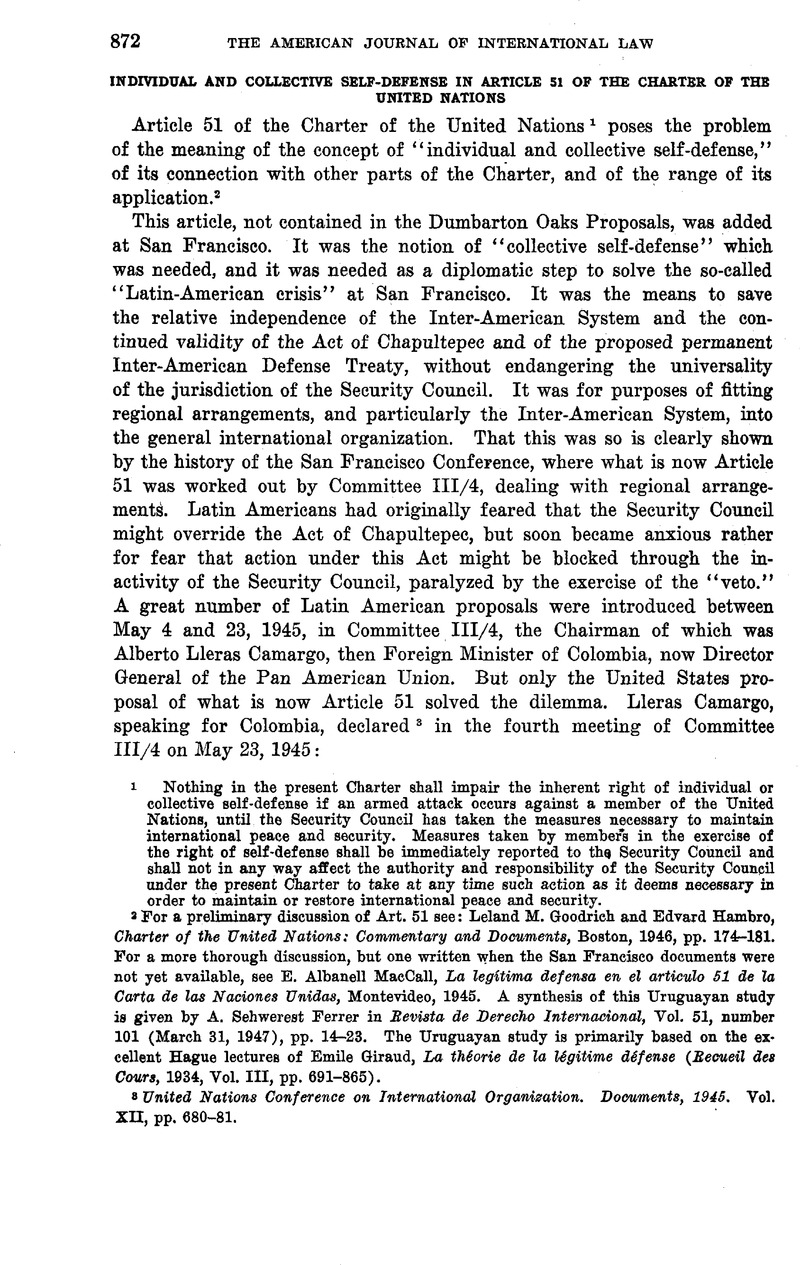Published online by Cambridge University Press: 20 April 2017

1 Nothing in the present Charter shall impair the inherent right of individual or collective self-defense if an armed attack occurs against a member of the United Nations, until the Security Council has taken the measures necessary to maintain international peace and security. Measures taken by members in the exercise of the right of self-defense shall be immediately reported to the. Security Council and shall not in any way affect the authority and responsibility of the Security Council under the present Charter to take at any time such action as it deems necessary in order to maintain or restore international peace and security.
2 For a preliminary discussion of Art. 51 see : Goodrich, Leland M. and Hambro, Edvard, Charter of the United Nations: Commentary and Documents. , Boston, 1946, pp. 174–181 Google Scholar. For a more thorough discussion, but one written when the San Francisco documents were not yet available, see MaeCall, E. Albaneil, La legítima defensa en el articulo 51 de la Carta de las Naciones Unidas. , Montevideo, 1945 Google Scholar. A synthesis of this Uruguayan study is given by Ferrer, A. Sehwerest in Bevista de Derecho Internacional. , Vol. 51, number 101 (March 31, 1947), pp. 14–23 Google Scholar. The Uruguayan study is primarily based on the excellent Hague lectures of Giraud, Emile, La théorie de la légitime défense. (Recueil des Cours, 1934, Vol. III, pp. 691–865 Google Scholar).
3 United Nations Conference on International Organization. Documents, 1945. Vol. XII, pp. 680-81.
4 The same, p. 687.
5 The same, Vol. XI, pp. 54-55.
6 In the same sense also : Report on the Action of the San Francisco Conference on Regional Arrangements, Submitted to the Governing Board by the Director General, Washington, Pan-American Union, 1945. Congress and Conference Series 48 (mimeographed).
7 Inter-American Conference for the Maintenance of Continental Peace and Security, Rio de Janeiro, Washington, 1946, pp. 143 (mimeographed).
8 Security Council 8/336, April 30, 1947.
9 See Steinlein, W., Der Begriff des nicht herausgeforderten Angriffs in Bündnisverträgen. , Leipzig, 1927 Google Scholar.
10 Descamps (Hague, Recueil des Cours, 1930, Vol. I, pp. 469-485) speaks of the concours à la légitime défense d’autrui.
11 In German Nothilfe as distinguished from Notwehr.
12 In Roman Law a slave had not only the right, but also the legal duty, to defend his master if the master found himself in a situation of self-defense.
13 Such person “has only the same right to defend another as he would have to defend himself under the same circumstances,” although “even a stranger may take life, if necessary, in order to prevent the commission of a felony by violence or surprise” ( Clark, and Marshall, , A Treatise on the Law of Crimes. , Chicago, 1940 (4th ed.), p. 359 Google Scholar).
14 It was, therefore, not correct, when Secretary of State Webster spoke, with regard to the Caroline Case of 1837, of the “great law of self-defense” ( Moore, J. B., Digest of International Law. , Vol. II, p. 412 Google Scholar). Necessity may be an excuse, but never a justification; in the common law of crimes necessity even as an excuse for homicide is doubtful. See Reg. v. Dudley and Stephens, L. R. 14, Q. B. Div. 273 (1884). See also Hall, Jerome, General Principles of Criminal Law. , Indianapolis, 1946 Google Scholar.
15 “Inherent right”; in the French text droit naturel; in the Spanish text derecho inmanente.
16 Already in Roman law : vim vi repellere licere Cassius scribit idque ins natura comparatur (Dig. 43, 16, 1, 27).
17 See the development in the common law of crimes: originally no excuse at all; then, under the Statute of Gloucester (6 Edw. 1, c. 9, 1278), the life of one who had killed se defendendo was released but his chattels forfeited ; later a full justification under the Statute of 24 Henry VIII, c 5, 1532. Yet the exercise of the right of self-defense presupposes the “retreat to the wall,” a condition wholly unknown to the countries of the Roman law.
18 Hyde, C. C., International Law. , Boston, 1922, Vol. I, p. 106 Google Scholar.
19 C. H. Hughes, 1923 ( Hackworth, , Digest of International Law. , Vol. IV, p. 451 Google Scholar).
20 Brierly, J. L., The Outlook for International Law. , Oxford, 1944, pp. 33–45.Google Scholar
21 H. Rep. 18, 77th Cong., 1st sess., p. 5 (Hackworth, work quoted, Vol. VII, pp. 692-93).
22 Circular Note of Secretary of State Kellogg of June 23, 1928.
23 Whereas the English and the Spanien texts use “armed attack” and ataque armado, the French text has the clearer term agréssion militaire.
24 Res. XXIV, Lima Conference, 1938.
25 Documents, work quoted, Vol. XII, pp. 341-349.
26 Luis E. Nieto Arteta, Intervención y dominio reservado del Estado (in the first [1947] number of the Sevista Colombiana de Derecho Internacional).